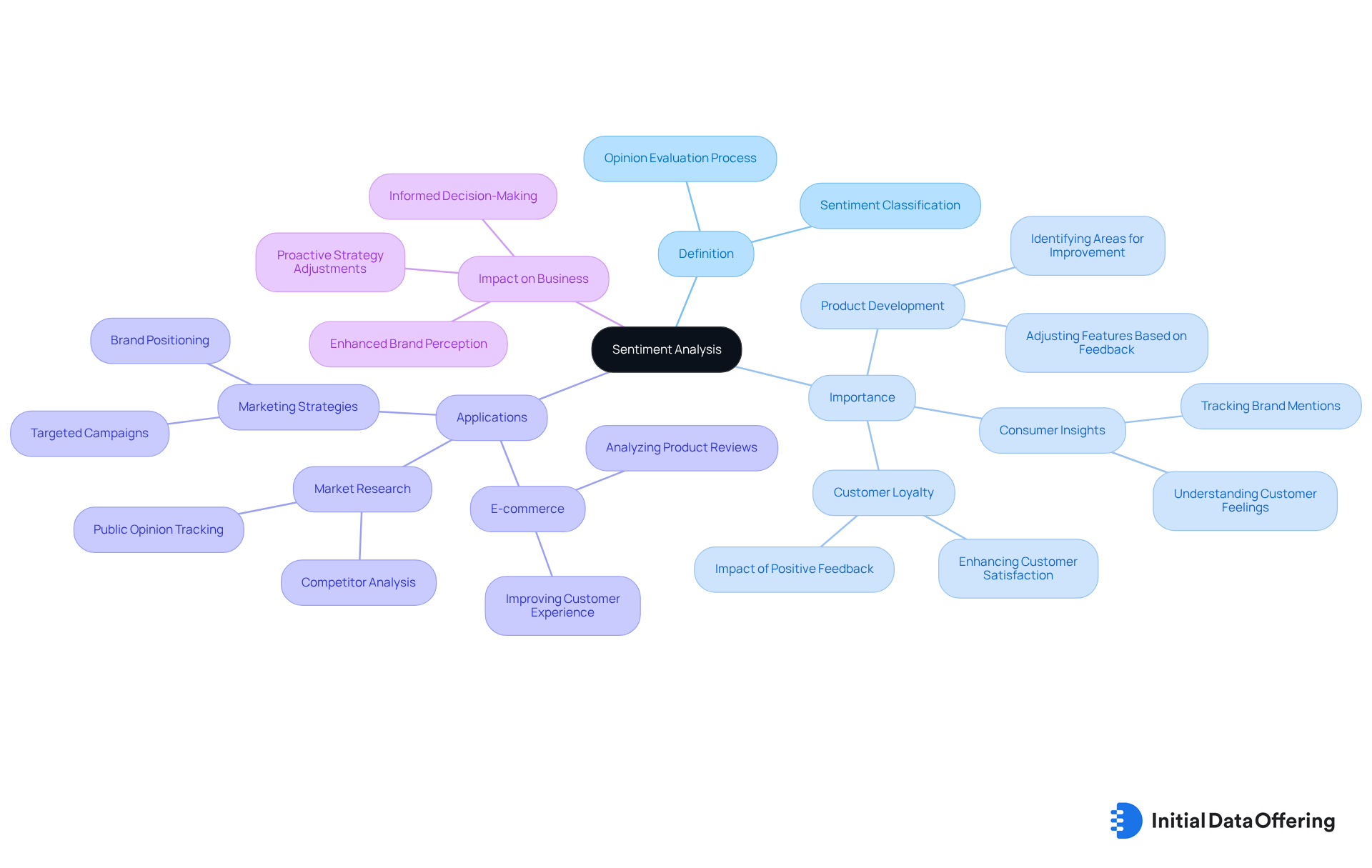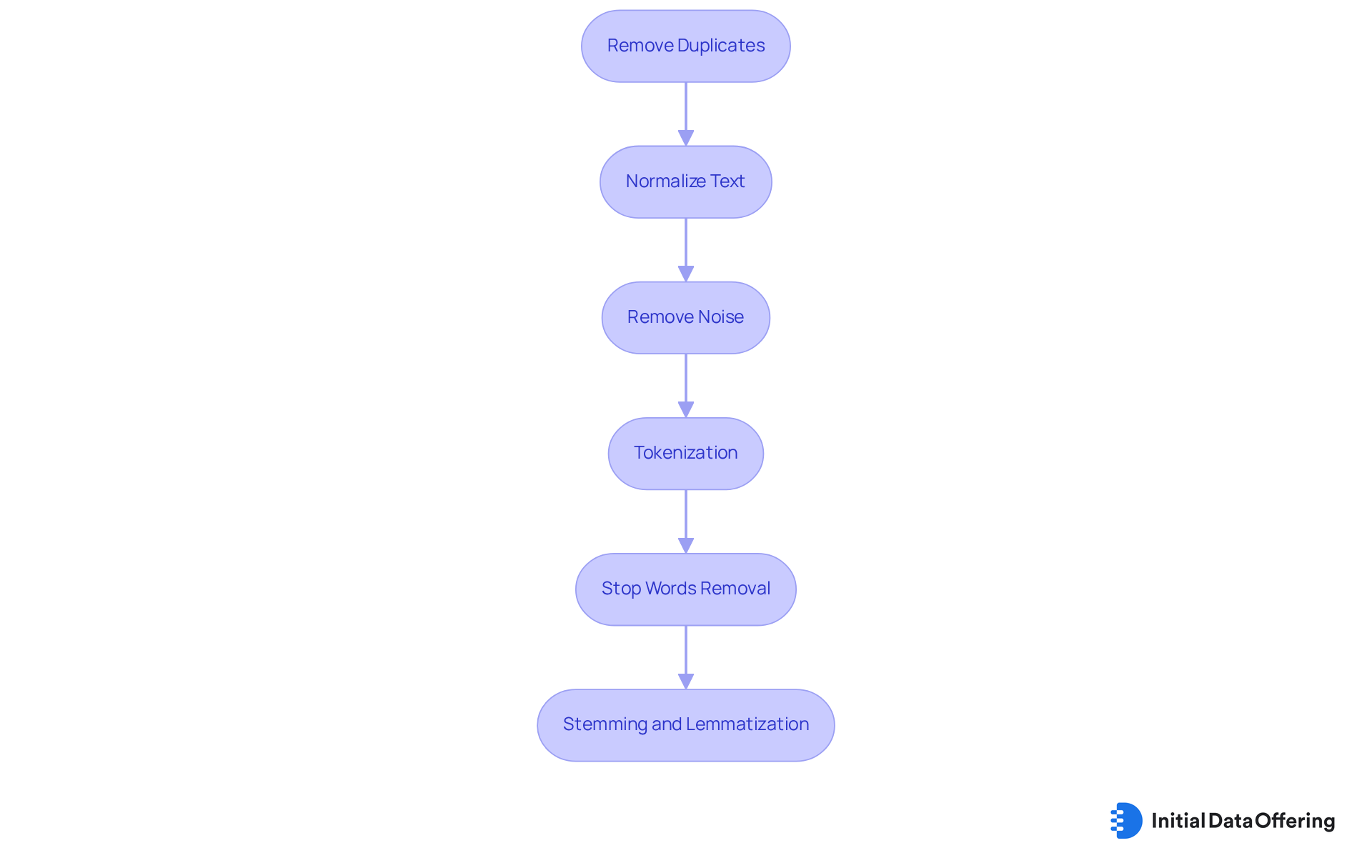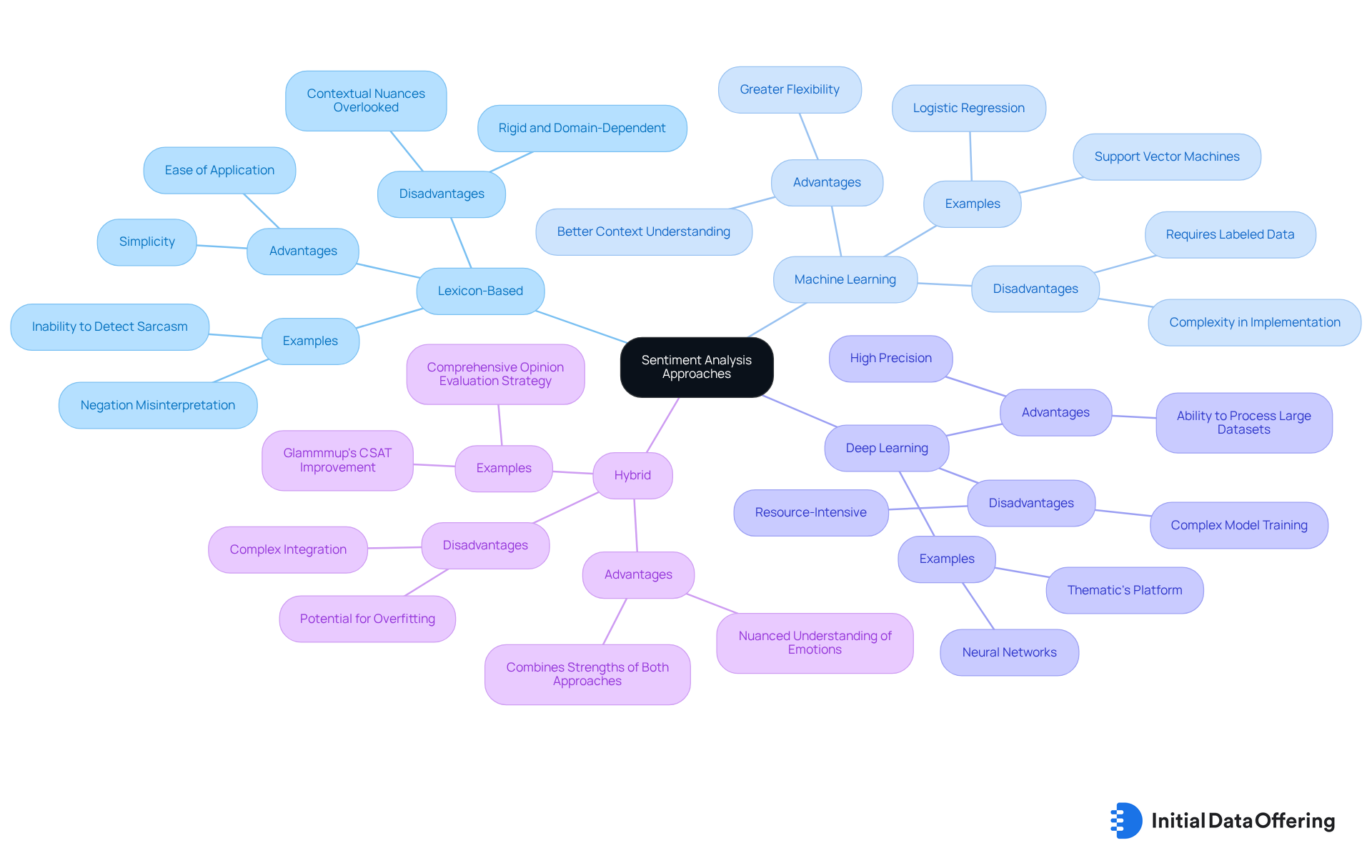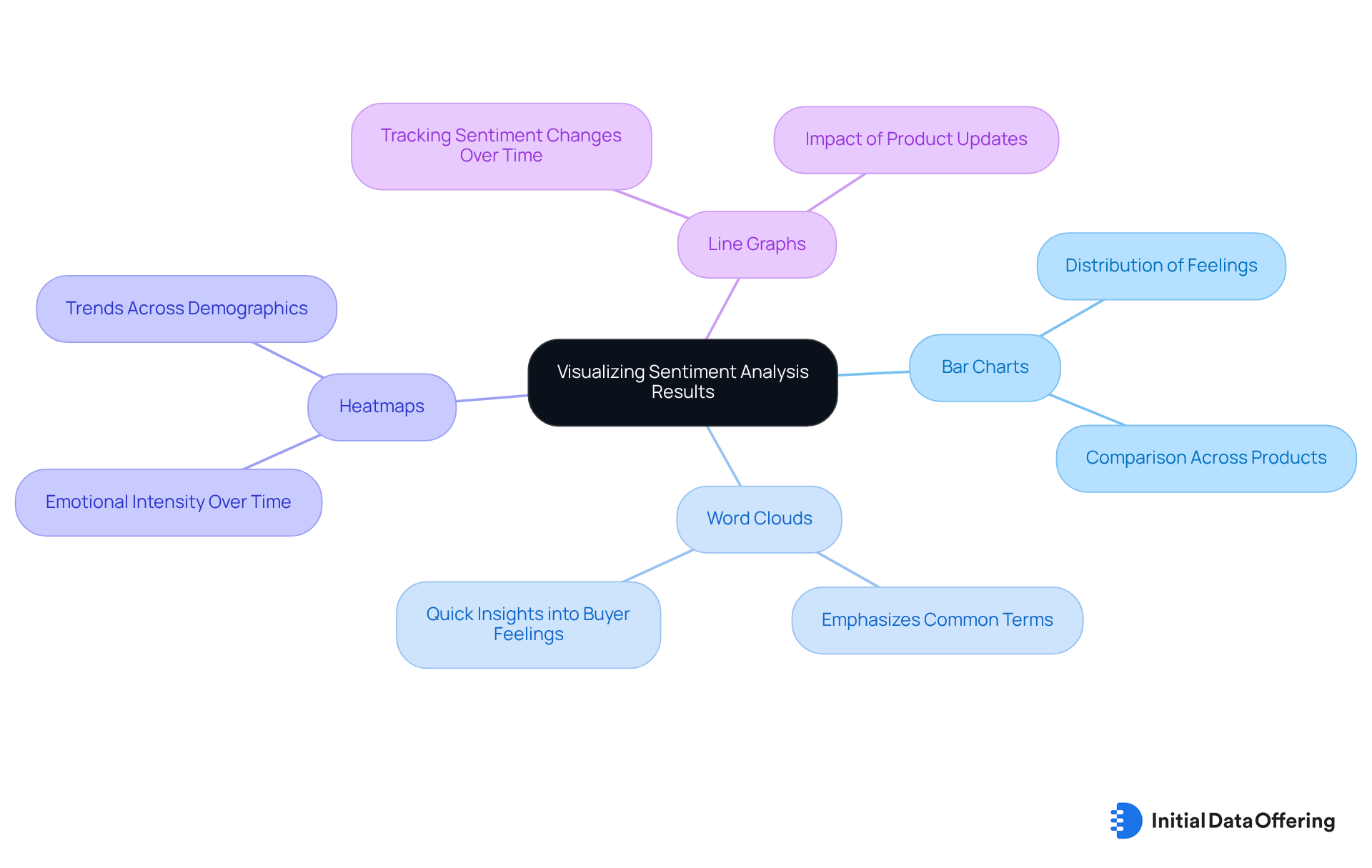5 Steps for Sentiment Analysis Using Product Review Data

5 Steps for Sentiment Analysis Using Product Review Data
Overview
The article presents a five-step process for conducting sentiment analysis using product review data, highlighting the critical importance of understanding consumer sentiment for business enhancement. This process includes:
- Data collection from diverse sources, ensuring a comprehensive dataset.
- Data cleaning and preprocessing, which are essential to prepare the data for analysis.
- Selecting suitable analysis methods tailored to specific business needs.
- Visualizing the results, which plays a pivotal role in translating complex data into actionable insights.
- Making informed decisions that enhance customer engagement and drive improvement.
How might this process apply to your own work? Consider the potential advantages of understanding consumer sentiment in your industry.
Introduction
Understanding consumer sentiment is a pivotal aspect of modern business strategy, particularly in the age of digital reviews and social media feedback. By harnessing the power of sentiment analysis, organizations can decode the emotional undertones of product reviews. This process transforms raw data into actionable insights that drive product development and enhance customer satisfaction.
However, the challenge lies in navigating the complexities of data collection, preprocessing, and analysis methods. How can businesses effectively implement sentiment analysis to not only gauge customer opinions but also foster loyalty and improve their offerings? This question invites organizations to explore the multifaceted benefits of sentiment analysis, ultimately leading to more informed decision-making and stronger customer relationships.
Define Sentiment Analysis and Its Importance
Opinion evaluation is a computational procedure that identifies and classifies views expressed in text. This process is crucial for determining whether the sentiment behind the text is positive, negative, or neutral. Its significance is particularly evident in sentiment analysis using product review data, as it enables businesses to understand consumer feelings and attitudes toward their products. By employing emotional evaluation, firms gain practical insights that inform product development, marketing strategies, and service improvements.
For instance, a rise in negative sentiments regarding a specific product feature can prompt immediate investigation and rectification. This proactive approach ultimately enhances customer satisfaction and fosters loyalty. Recent trends indicate that opinion evaluation achieves an , underscoring its reliability. Moreover, analyzing client feedback through emotional assessment helps companies pinpoint areas for improvement, enhancing their offerings by tracking brand mentions on social media platforms.
Interestingly, customers who provide positive feedback are 31% more likely to make a purchase, illustrating the significant impact of emotional assessment on customer satisfaction and loyalty. A case study on feedback evaluation exemplifies how sentiment analysis using product review data assists online businesses in gauging customer sentiments and refining products, offering a concrete illustration of its application.
How might your organization leverage opinion evaluation to enhance customer engagement and satisfaction?

Collect Product Review Data from Various Sources
To perform efficient sentiment analysis, it is essential to begin by from diverse sources. Key platforms include:
- e-commerce websites like Amazon
- rating aggregators such as Trustpilot
- social media channels where customers share their opinions
Utilizing APIs significantly enhances the efficiency of this process. For instance, the Amazon Product Advertising API enables direct retrieval of feedback, simplifying data collection. Capturing both the evaluation text and pertinent metadata, including ratings and timestamps, is crucial, as these components are essential for thorough examination.
Furthermore, employing web scraping tools such as PromptCloud can automate the gathering of client feedback, ensuring timely and organized datasets. Aim for a varied dataset that encompasses a wide range of customer feelings and experiences. This approach establishes a strong basis for your evaluation.
How might these diverse data sources enrich your understanding of customer sentiment? By leveraging these tools and strategies, you can gain a comprehensive view of customer feedback, ultimately leading to more informed decision-making.

Clean and Preprocess Review Data for Analysis
Cleaning and preprocessing product feedback data is essential for conducting sentiment analysis using product review data. This process encompasses several key actions that enhance the derived from the data.
- Remove Duplicates: Eliminating duplicate reviews is vital. Each entry must contribute uniquely to the evaluation, preventing skewed results and enhancing the reliability of insights.
- Normalize Text: Converting all text to lowercase ensures consistency across the dataset. This practice allows for accurate comparisons and mitigates the risk of misinterpretation. Industry leaders emphasize that text normalization is crucial for achieving dependable emotion evaluation results.
- Remove Noise: It's important to eliminate unnecessary characters, such as punctuation, special symbols, and HTML tags. These elements can introduce noise and complicate the evaluation process. Numerous studies highlight that adequate data cleansing methods are critical for achieving precise outcomes in sentiment analysis using product review data.
- Tokenization: Breaking down the text into individual words or tokens simplifies analysis. This approach enables a more detailed examination of the feelings expressed in the reviews.
- Stop Words Removal: Common words (e.g., 'and', 'the', 'is') that do not contribute to emotion should be removed. This enhances the focus on meaningful terms, allowing for a clearer understanding of sentiments.
- Stemming and Lemmatization: Reducing words to their base or root forms ensures that variations of a word are treated as the same term. This enhances the precision of opinion classification and is particularly significant for managing differences in word forms during emotion assessment.
By adhering to these best practices, you will cultivate a clean and robust dataset, primed for insightful evaluations, such as sentiment analysis using product review data, that can lead to informed decision-making. Statistics reveal that high-quality information profoundly influences the efficiency of opinion assessment, making these preprocessing steps not merely advantageous but essential. How might these practices enhance your own data evaluation processes?

Choose a Suitable Sentiment Analysis Approach
In sentiment analysis using product review data, various approaches present unique features, advantages, and benefits, each contributing to the understanding of emotional tone in text.
- Lexicon-Based Approach: This method relies on established lists of words linked to positive or negative emotions. Its simplicity and ease of application are notable advantages; however, it often overlooks contextual nuances, potentially leading to inaccuracies in emotion classification. For example, lexicon-based methods may falter with sarcasm or negation. Ezgi Arslan highlights that these methods are rigid and domain-dependent, which can result in misinterpretations. Thus, while useful, the lexicon-based approach may not always capture the full emotional spectrum.
- Machine Learning Approach: By training models on labeled datasets, this approach offers greater flexibility and a superior ability to grasp context compared to lexicon-based methods. Techniques such as logistic regression and support vector machines are frequently employed due to their effectiveness in classifying emotions. Alex Blyakhman emphasizes that emotional interpretation methods are vital tools for analyzing large volumes of text for emotional tone and significance, underscoring the importance of machine learning in this domain.
- Deep Learning Approach: Utilizing neural networks, deep learning excels at detecting complex patterns within extensive datasets. This method is particularly advantageous for sentiment analysis using product review data, as it can process large amounts of unstructured text and achieve . For instance, Thematic's platform has shown that deep learning can significantly enhance emotional evaluation accuracy, achieving correct predictions in 96% of cases. This capability makes deep learning a powerful ally in sentiment analysis.
- Hybrid Approach: Merging lexicon-based and machine learning techniques can yield improved results by leveraging the strengths of both. This hybrid approach allows for a more nuanced understanding of emotions, especially in contexts where subtleties matter. The effectiveness of this combination is illustrated by Glammmup, which increased its customer satisfaction ratings (CSAT) from 62 to 82 by implementing a comprehensive opinion evaluation strategy.
Selecting the appropriate method for emotion analysis hinges on the scale and complexity of your dataset, as well as the specific insights you aim to extract. As trends in machine learning and deep learning evolve, these approaches are becoming increasingly adept at providing actionable insights through sentiment analysis using product review data and customer feedback. How might these advancements influence your understanding of customer sentiment?

Visualize Sentiment Analysis Results for Insights
After conducting sentiment analysis using product review data, the next step is to visualize the results to derive actionable insights. Effective visualization techniques can significantly enhance your understanding of data.
- Bar Charts: These are useful for illustrating the distribution of feelings—positive, negative, and neutral—across various products or categories. By presenting this data visually, you can quickly identify which areas require attention or improvement.
- Word Clouds: Generating word clouds can emphasize commonly referenced terms in positive or negative evaluations. This rapid visual depiction offers immediate insights into buyer feelings, allowing for quick adjustments in strategy.
- Heatmaps: Utilizing heatmaps to display emotional intensity over time or across demographics assists in identifying trends and patterns. This method provides a clear visual representation of how sentiments fluctuate through sentiment analysis using product review data, enabling targeted responses.
- Line Graphs: Plotting sentiment scores over time allows for tracking changes in customer sentiment. This technique is particularly useful for of product updates or marketing campaigns, providing a clear timeline of customer reactions.
By employing these visualization techniques, you effectively communicate your findings and support data-driven decision-making, particularly through sentiment analysis using product review data. How might these methods apply to your current projects?

Conclusion
Sentiment analysis serves as a vital tool for businesses aiming to decode consumer emotions and attitudes expressed in product reviews. By systematically evaluating these sentiments, organizations can gain invaluable insights that drive product improvements, enhance marketing strategies, and ultimately boost customer satisfaction and loyalty. The process of sentiment analysis involves several critical steps:
- Data collection
- Preprocessing
- Method selection
- Visualization
Each of these steps contributes significantly to the overall effectiveness of understanding customer feedback.
Throughout the article, we have discussed key elements such as the importance of collecting diverse product review data, the necessity of thorough data cleaning, and the various approaches to sentiment analysis. Techniques ranging from lexicon-based methods to advanced machine learning and deep learning approaches highlight the evolving landscape of sentiment analysis. Furthermore, effective visualization techniques—such as bar charts and word clouds—enable businesses to communicate findings and make informed decisions based on emotional evaluations.
In conclusion, harnessing sentiment analysis through product review data presents a significant opportunity for organizations to deepen their understanding of customer sentiment and enhance engagement strategies. By adopting these practices and tools, businesses can proactively respond to consumer feedback, leading to improved products and services that resonate with their audience. Embracing sentiment analysis not only empowers companies to refine their offerings but also fosters a culture of responsiveness and customer-centricity, which is essential in today’s competitive marketplace.
Frequently Asked Questions
What is sentiment analysis and why is it important?
Sentiment analysis is a computational process that identifies and classifies opinions expressed in text as positive, negative, or neutral. It is important because it helps businesses understand consumer feelings and attitudes toward their products, informing product development, marketing strategies, and service improvements.
How can sentiment analysis impact customer satisfaction and loyalty?
By identifying negative sentiments regarding a product, businesses can investigate and rectify issues, which enhances customer satisfaction. Additionally, positive feedback increases the likelihood of purchases, with customers who provide positive feedback being 31% more likely to buy.
What is the accuracy level of sentiment analysis?
Recent trends indicate that sentiment analysis achieves an accuracy level of 70-80%, demonstrating its reliability.
What are some sources for collecting product review data?
Key sources for collecting product review data include e-commerce websites like Amazon, rating aggregators such as Trustpilot, and social media channels where customers share their opinions.
How can APIs enhance the data collection process for sentiment analysis?
APIs, such as the Amazon Product Advertising API, enable direct retrieval of feedback, simplifying the data collection process and capturing both evaluation text and relevant metadata like ratings and timestamps.
What tools can automate the gathering of client feedback?
Web scraping tools, such as PromptCloud, can automate the collection of client feedback, ensuring timely and organized datasets.
Why is it important to have a varied dataset in sentiment analysis?
A varied dataset that encompasses a wide range of customer feelings and experiences establishes a strong basis for thorough evaluation, leading to a comprehensive understanding of customer sentiment.